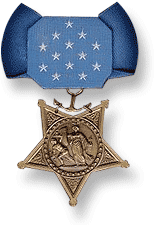Anthony Casamento
| Anthony Casamento | |
|---|---|
  Casamento (above) is presented the Medal of Honor (pictured below) by President Jimmy Carter at the White House | |
| Born |
November 16, 1920 Manhattan, New York |
| Died |
July 18, 1987 (aged 66) Northport, New York |
| Place of burial | Long Island National Cemetery |
| Allegiance |
|
| Service/branch |
|
| Years of service | 1940 - 1946 |
| Rank |
|
| Unit | 1st Battalion 5th Marines |
| Battles/wars |
World War II Battle of Guadalcanal |
| Awards |
Medal of Honor Purple Heart |
Corporal Anthony Casamento, (November 16, 1920–July 18, 1987) was presented the Medal of Honor by President Jimmy Carter on September 12, 1980 in a ceremony in the White House Rose Garden, 38 years after Cpl Casamento's heroism on Guadalcanal in 1942.
Biography
Casamento was born November 16, 1920 in Manhattan, New York. He enlisted in the Marine Corps on August 19, 1940 in New York City. After completing recruit training at the Marine Corps Recruit Depot Parris Island, South Carolina, he was assigned to the 5th Marines, 1st Marine Division.
Military career
Six months after the Japanese attack on Pearl Harbor, the 5th Marines was on its way to the southwest Pacific to take part in the initial invasion of Japanese-held territory as part of the 1st Marine Division. The Marine landing on Guadalcanal began in August 1942 and Cpl Casamento made the assault with Company D, 1st Battalion, 5th Marines.
On November 1, 1942, while serving as a leader of a machine gun squad in an attack on Japanese positions, Cpl Casamento's Marines came under heavy enemy fire near the Matanikau River. During the ensuing battle, all members of the unit were either killed or severely wounded. Despite his own multiple wounds, Cpl Casamento continued to provide supporting fire and heroically held the enemy at bay, thereby protecting the flanks of adjoining companies until he was physically unable to continue.
Post War
Corporal Casamento was treated at a medical aid station, then shipped back to the United States and admitted to the naval hospital in Oakland, California.
In 1964, it was learned that two eyewitnesses to Cpl Casamento's heroism were still alive. That set in motion a chain of events that would ultimately result in his receiving the Medal of Honor in 1980.
Corporal Casamento died July 27, 1987 in the VA hospital in Northport, New York, after a long illness.
Decorations
In addition to the Medal of Honor, Cpl Casamento's awards include the Purple Heart, the Presidential Unit Citation, the American Defense Service Medal, the American Campaign Medal, the Asiatic-Pacific Medal with two bronze stars (for Guadalcanal-Tulagi Landings and Capture and Defense of Guadalcanal), and the World War II Victory Medal
| Medal of Honor | ||
| Purple Heart | Presidential Unit Citation | American Defense Service Medal |
| American Campaign Medal | Asiatic-Pacific Campaign Medal with two bronze stars | World War II Victory Medal |
Medal of Honor citation
The President of the United States in the name of The Congress takes pleasure in presenting the MEDAL OF HONOR to
CORPORAL ANTHONY CASAMENTO
UNITED STATES MARINE CORPS
for service as set forth in the following CITATION:
For conspicuous gallantry and intrepidity at the risk of his life above and beyond the call of duty while serving with Company "D", First Battalion, Fifth Marines, First Marine Division on Guadalcanal, British Solomon Islands, in action against the enemy Japanese forces on November 1, 1942. Serving as a leader of a machine gun section, Corporal Casamento directed his unit to advance along a ridge near the Matanikau River where they engaged the enemy. He positioned his section to provide covering fire for two flanking units and to provide direct support for the main force of his company which was behind him. During the course of this engagement, all members of his section were either killed or severely wounded and he himself suffered multiple, grievous wounds. Nonetheless, Corporal Casamento continued to provide critical supporting fire for the attack and in defense of his position. Following the loss of all effective personnel, he set up, loaded, and manned his unit's machine gun, tenaciously holding the enemy forces at bay. Corporal Casamento single-handedly engaged and destroyed one machine gun emplacement to his front and took under fire the other emplacement on the flank. Despite the heat and ferocity of the engagement, he continued to man his own weapon and repeatedly repulsed multiple assaults by the enemy forces, thereby protecting the flanks of the adjoining companies and holding his position until the arrival of his main attacking force. Corporal Casamento's courageous fighting spirit, heroic conduct, and unwavering dedication to duty reflected great credit upon himself and were in keeping with the highest traditions of the Marine Corps and the United States Naval Service.
/S/ JIMMY CARTER
A park in West Islip, NY (his postwar residence) is named after him as is a stretch of highway in Farmingdale, NY.
See also
- List of Medal of Honor recipients
- List of Medal of Honor recipients for World War II
- List of Italian American Medal of Honor recipients
References
 This article incorporates public domain material from websites or documents of the United States Marine Corps.
This article incorporates public domain material from websites or documents of the United States Marine Corps.
- "Corporatl Anthony Casamento, USMC". Who's Who in Marine Corps History. History Division, United States Marine Corps. Retrieved 14 June 2009.
- "Medal of Honor — CPL Anthony Casamento". Marines Awarded the Medal of Honor. United States Marine Corps. Archived from the original on 2007-03-05.